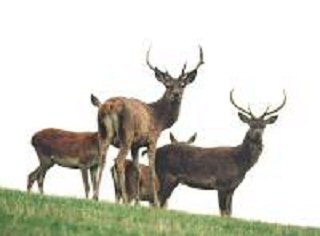
RED DEER. A source of joy and a prime feature of Exmoor, indeed many would say ‘The Pride of Exmoor’. There are around 3000 mature red deer on Exmoor and no matter how many times they have been seen, the sight of a big stag with a full head of antlers is guaranteed to bring a thrill.
There has been a shortage of mature stags in recent years which inevitably leads to a weakening of the stock, but it is hoped things are now improving. Hunting on Exmoor is a way of life for many and one benefit of this has been that much of the moor has been kept open and unfenced. The policy of ENHS is neither for or against hunting but the welfare of the deer is paramount. The rut or mating season takes place in the Autumn when the sound of stags roaring defiance to each other in the twilight can send a chill to the spine.
Around June the hinds drop their young (called calves not fawns) in scrub or bracken and move away some distance so as not to draw attention to them. They come back every few hours to feed them so if you find an apparently abandoned calf DO NOT TOUCH IT. Your smell may cause the mother to desert it and they are almost impossible to rear in captivity. The stags drop their antlers each Spring and regrow them. Searching for cast antlers is a prime sport for local youths.
Our Society has conducted several deer counts on Exmoor in the past and the numbers arrived at (between 3 – 4 thousand) agree with professional counts which have taken place more recently.
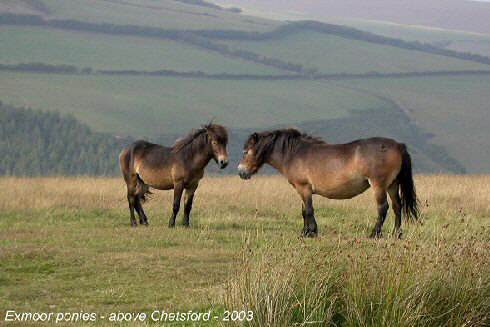
EXMOOR PONIES. An ancient breed of wild pony which has lived on Exmoor from time immemorial. In 1777 the stock of ponies in the Royal Forest was 422. When the Crown sold the Forest in 1818 the ponies were disposed of by auction except for 20 of the best. These were sent to Ashway Farm owned by Sir Thomas Acland, and allowed to run on Winsford Hill. It is from these 20 ponies that the present day pure bred herds have descended. Although not wild in the true sense of the word – all have owners – they run wild on the moor for part of their lives. A recent saying that they were “rarer than the giant panda” in numbers has prompted the National Park Authority to obtain some herds of their own and they may now be seen on North Hill, Minehead and Ley Hill as well as in their traditional locations such as Withypool Common, Winsford Hill and Brendon Common.
DORMOUSE (Muscardinus avellanarius)
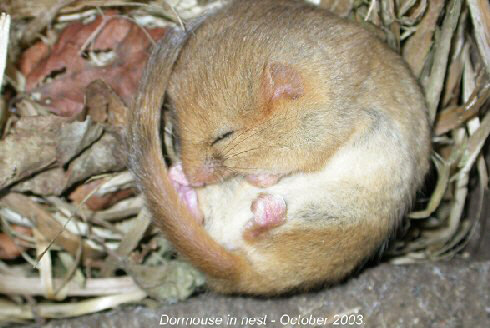
These charming creatures, not mice but nearer to squirrels, are included in the Biodiversity Action Plan for Exmoor. Attempts to increase breeding by installing nest boxes are taking place in several areas including one site of 50 boxes which are monitored by licensed members of Exmoor Natural History Society. Sometimes called the Hazel Dormouse because of their liking for hazel nuts, they in fact need a varied diet of berries and seeds. They spend many months asleep in winter and need to fatten up with food beforehand.
ELEPHANT HAWK-MOTH (Deilephila elpenor)
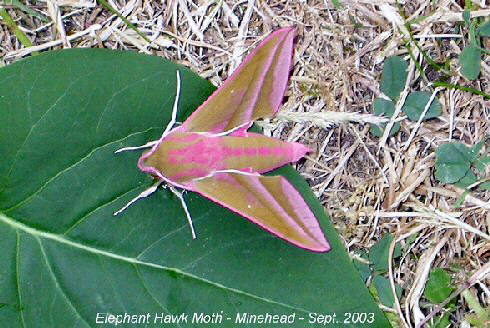
A common but striking moth which frequently comes to light traps in July. It may also be seen feeding at Honeysuckle flowers at dusk. Its long tongue enables it to reach nectar at the bottom of the flower tubes. The larva has a trunk-like snout which gives this moth its name. When disturbed the snout is retracted and the head swells up showing a large menacing eye-spot to scare away predators. The larvae feed on willowherbs and bedstraws. These were abundant in 2003 during a trapping exercise at Malmsmead Natural History Centre.
HEATH FRITILLARY (Mellicta athalia)
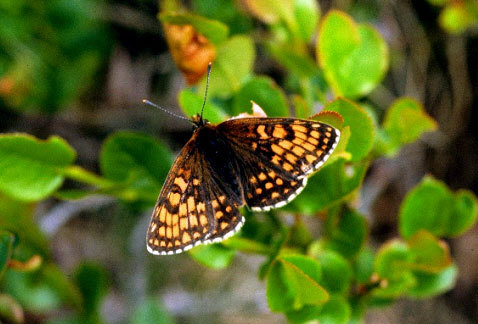
In 1982, Roger Butcher, ENHS Ecologist and Bird Recorder, found a dead Heath Fritillary butterfly in an Exmoor combe. He took this to Noel Allen at Alcombe Books for confirmation and after this they surveyed all suitable Exmoor sites finding tens of thousands of Heath Fritillaries in about 20 areas. Previously, this butterfly was only known to breed in Kent and Cornwall. The food-plant of the larva is cow-wheat which is semi-parasitic on whortleberry but they are occasionally found on foxglove. It is a RDB2 species.
Numbers remained high until a decline in the 1990’s after which they dropped to just tens in two or three sites following a series of wet, cold June’s, their main flight period. Recently, however, they have begun to make a come-back but numbers still barely reach hundreds rather than thousands. ENHS members have surveyed this species every year since 1982.